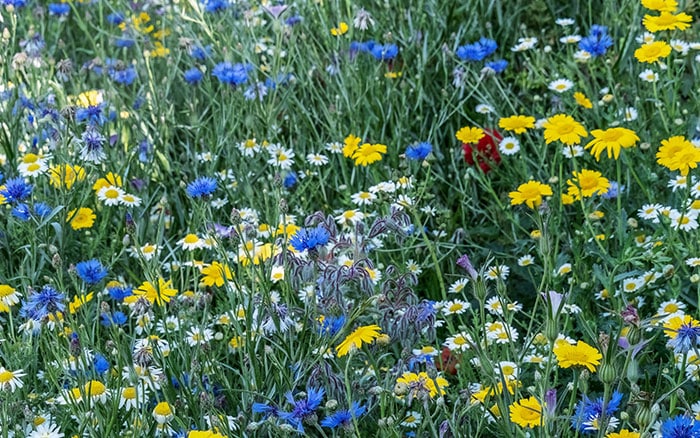Borage is a fantastically useful, easy-to-grow annual herb that will self-seed if the soil conditions around it are right. The bright blue flowers are edible and can be frozen in ice cubes or sprinkled in salads and drinks.
What is the botanical name for Borage?
Borago is in the family Boraginaceae with its 2000 different species including forget-me-not, comfrey and lung wort.
What are the common names for Borage?
Borage.
Where is it native to?
This plant is native to the eastern mediterranean region and widely grown in the UK, North America and various parts of Europe.

What does it look like?
Plants produce clumps of bristly leaves that smell and have a mild taste of cucumber! Clusters of star-like bright-blue flowers are produced during the summer months into early autumn from upright stems.
What colours do they come in?
Flower colours are mainly bright blue, but there are white cultivars too.


Where does Borage like to grow?
Borage will grow in any average soil, preferably in full sun. They’ll tolerate dry soil but will not grow well in deep shade or continuously wet soil.
How do you grow it successfully?
This plant is an annual and so seeds will need to be sown yearly in the spring. There is one perennial, Corsican Borage.
Is Borage good for pollinators?
The sky-blue single flowers of this plant make it extremely attractive to pollinating insects, particularly bees.
How to choose the right Borage for your garden?
There are less than a handful of borage cultivars so it would mainly be down to flower colour choice; the sky-blue of B. officinalis or the pure white of B. officinalis ‘Alba’.


How big will my Borage get?
With the exception of a ground creeping cultivar, most varieties reach an average height of around 60cm and a width of 20cm.
When to plant it?
Most borage are annuals. Seeds should be sown in the spring and planted out in early June, once all risk of frost has passed.
How to care for them?
Apart from watering plants in well on planting and regularly for the first two weeks after planting borage are self-reliant and need no special care, as long as they are given good growing conditions.

How do I keep my Borage looking good?
Borage do not usually need any special care and attention but if growing in containers it’s a good idea to add a balanced fertiliser to the compost in the spring, like blood, fish and bone.
How do I propagate Borage?
Annual borage can be grown from seed collected at the end of the summer. Sow seeds in seed sowing compost in spring, scattering the seed over the firmed compost surface and lightly covering with a thin layer of compost.
Water and keep in a light, warm place until seedlings germinate, then prick out into individual modules, growing on until it’s safe to plant outside, after all risk of frost has passed.
An easier way to propagate borage is to collect the seed and scatter it over the ground in the spring.
The pygmy borage (B. pygmaea) can be propagated by division in early spring.

What problems can Borage have?
Borage are generally trouble free but B. officinalis can suffer from powdery mildew. If this occurs, it’s usually at the end of the summer when the plant is coming to the end of its annual life and therefore can just be pulled up and composted.
What varieties should you look out for?
There are just a few different varieties to look out for:
There are just a few different borage to look out for. Borago officinalis, the annual herb and B. officinalis ‘Alba’, the white flowered cultivar.
There’s also a variegated leaf cultivar B. officinalis ‘Bill Archer’ and a light blue flower creeping variety B. pygmaea.



When should I buy Borage?
Seeds of the annual herb are available year round to be sown in spring. ‘Bill Archer’ and pygmaea should be bought and planted in spring.
Which garden design styles does Borage work best in?
Borage plants work well in informal plantings such as cottage garden styles and gravel gardens. This is where the blue flowers stand out well, and star-shaped blooms add a magical touch.
This magical, pollinator-friendly flowers create a lovely pop of colour in the garden.

Leave A Comment